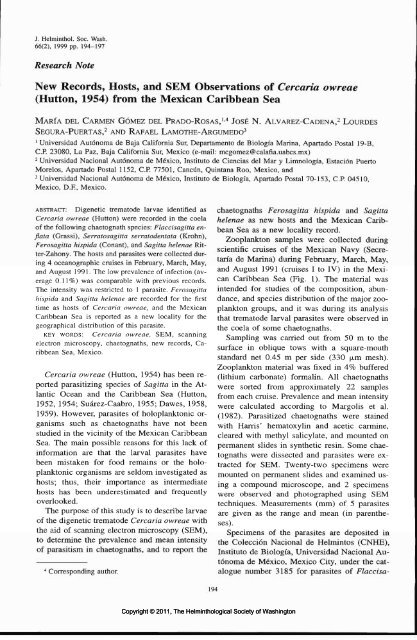The Helminthological Society of Washington - Peru State College
The Helminthological Society of Washington - Peru State College
The Helminthological Society of Washington - Peru State College
You also want an ePaper? Increase the reach of your titles
YUMPU automatically turns print PDFs into web optimized ePapers that Google loves.
J. Helminthol. Soc. Wash.<br />
66(2), 1999 pp. 194-197<br />
Research Note<br />
New Records, Hosts, and SEM Observations <strong>of</strong> Cercaria owreae<br />
(Hutton, 1954) from the Mexican Caribbean Sea<br />
DEL CARMEN GOMEZ DEL PRAoo-RosAS,1'4 JOSE N. ALVAREZ-CADENA,2 LOURDES<br />
SEGURA-PUERTAS,2 AND RAFAEL LAMOTHE-ARGUMEDO3<br />
1 Universidad Autonoma de Baja California Sur, Departamento de Biologia Marina, Apartado Postal 19-B,<br />
C.P. 23080, La Paz, Baja California Sur, Mexico (e-mail: mcgomez@calafia.uabcs.mx)<br />
2 Universidad Nacional Autonoma de Mexico, Institute de Ciencias del Mar y Limnologia, Estacion Puerto<br />
Morelos, Apartado Postal 1152, C.P. 77501, Canctin, Quintana Roo, Mexico, and<br />
3 Universidad Nacional Autonoma de Mexico, Institute de Biologia, Apartado Postal 70-153, C.P. 04510,<br />
Mexico, D.F., Mexico.<br />
ABSTRACT: Digenetic trematode larvae identified as<br />
Cercaria owreae (Hutton) were recorded in the coela<br />
<strong>of</strong> the following chaetognath species: Flaccisagitta enflata<br />
(Grassi), Serratosagitta serratodentata (Krohn),<br />
Ferosagitta hispida (Conant), and Sagitta helenae Ritter-Zahony.<br />
<strong>The</strong> hosts and parasites were collected during<br />
4 oceanographic cruises in February, March, May,<br />
and August 1991. <strong>The</strong> low prevalence <strong>of</strong> infection (average<br />
0.11%) was comparable with previous records.<br />
<strong>The</strong> intensity was restricted to 1 parasite. Ferosagitta<br />
hispida and Sagitta helenae are recorded for the first<br />
time as hosts <strong>of</strong> Cercaria owreae, and the Mexican<br />
Caribbean Sea is reported as a new locality for the<br />
geographical distribution <strong>of</strong> this parasite.<br />
KEY WORDS: Cercaria owreae, SEM, scanning<br />
electron microscopy, chaetognaths, new records, Caribbean<br />
Sea, Mexico.<br />
Cercaria owreae (Hutton, 1954) has been reported<br />
parasitizing species <strong>of</strong> Sagitta in the Atlantic<br />
Ocean and the Caribbean Sea (Hutton,<br />
1952, 1954; Suarez-Caabro, 1955; Dawes, 1958,<br />
1959). However, parasites <strong>of</strong> holoplanktonic organisms<br />
such as chaetognaths have not been<br />
studied in the vicinity <strong>of</strong> the Mexican Caribbean<br />
Sea. <strong>The</strong> main possible reasons for this lack <strong>of</strong><br />
information are that the larval parasites have<br />
been mistaken for food remains or the holoplanktonic<br />
organisms are seldom investigated as<br />
hosts; thus, their importance as intermediate<br />
hosts has been underestimated and frequently<br />
overlooked.<br />
<strong>The</strong> purpose <strong>of</strong> this study is to describe larvae<br />
<strong>of</strong> the digenetic trematode Cercaria owreae with<br />
the aid <strong>of</strong> scanning electron microscopy (SEM),<br />
to determine the prevalence and mean intensity<br />
<strong>of</strong> parasitism in chaetognaths, and to report the<br />
Corresponding author.<br />
chaetognaths Ferosagitta hispida and Sagitta<br />
helenae as new hosts and the Mexican Caribbean<br />
Sea as a new locality record.<br />
Zooplankton samples were collected during<br />
scientific cruises <strong>of</strong> the Mexican Navy (Secretaria<br />
de Marina) during February, March, May,<br />
and August 1991 (cruises I to IV) in the Mexican<br />
Caribbean Sea (Fig. 1). <strong>The</strong> material was<br />
intended for studies <strong>of</strong> the composition, abundance,<br />
and species distribution <strong>of</strong> the major zooplankton<br />
groups, and it was during its analysis<br />
that trematode larval parasites were observed in<br />
the coela <strong>of</strong> some chaetognaths.<br />
Sampling was carried out from 50 m to the<br />
surface in oblique tows with a square-mouth<br />
standard net 0.45 m per side (330 fjim mesh).<br />
Zooplankton material was fixed in 4% buffered<br />
(lithium carbonate) formalin. All chaetognaths<br />
were sorted from approximately 22 samples<br />
from each cruise. Prevalence and mean intensity<br />
were calculated according to Margolis et al.<br />
(1982). Parasitized chaetognaths were stained<br />
with Hams' hematoxylin and acetic carmine,<br />
cleared with methyl salicylate, and mounted on<br />
permanent slides in synthetic resin. Some chaetognaths<br />
were dissected and parasites were extracted<br />
for SEM. Twenty-two specimens were<br />
mounted on permanent slides and examined using<br />
a compound microscope, and 2 specimens<br />
were observed and photographed using SEM<br />
techniques. Measurements (mm) <strong>of</strong> 5 parasites<br />
are given as the range and mean (in parentheses).<br />
Specimens <strong>of</strong> the parasites are deposited in<br />
the Coleccion Nacional de Helmintos (CNHE),<br />
Institute de Biologia, Universidad Nacional Autonoma<br />
de Mexico, Mexico City, under the catalogue<br />
number 3185 for parasites <strong>of</strong> Flaccisa-<br />
194<br />
Copyright © 2011, <strong>The</strong> <strong>Helminthological</strong> <strong>Society</strong> <strong>of</strong> <strong>Washington</strong>
















